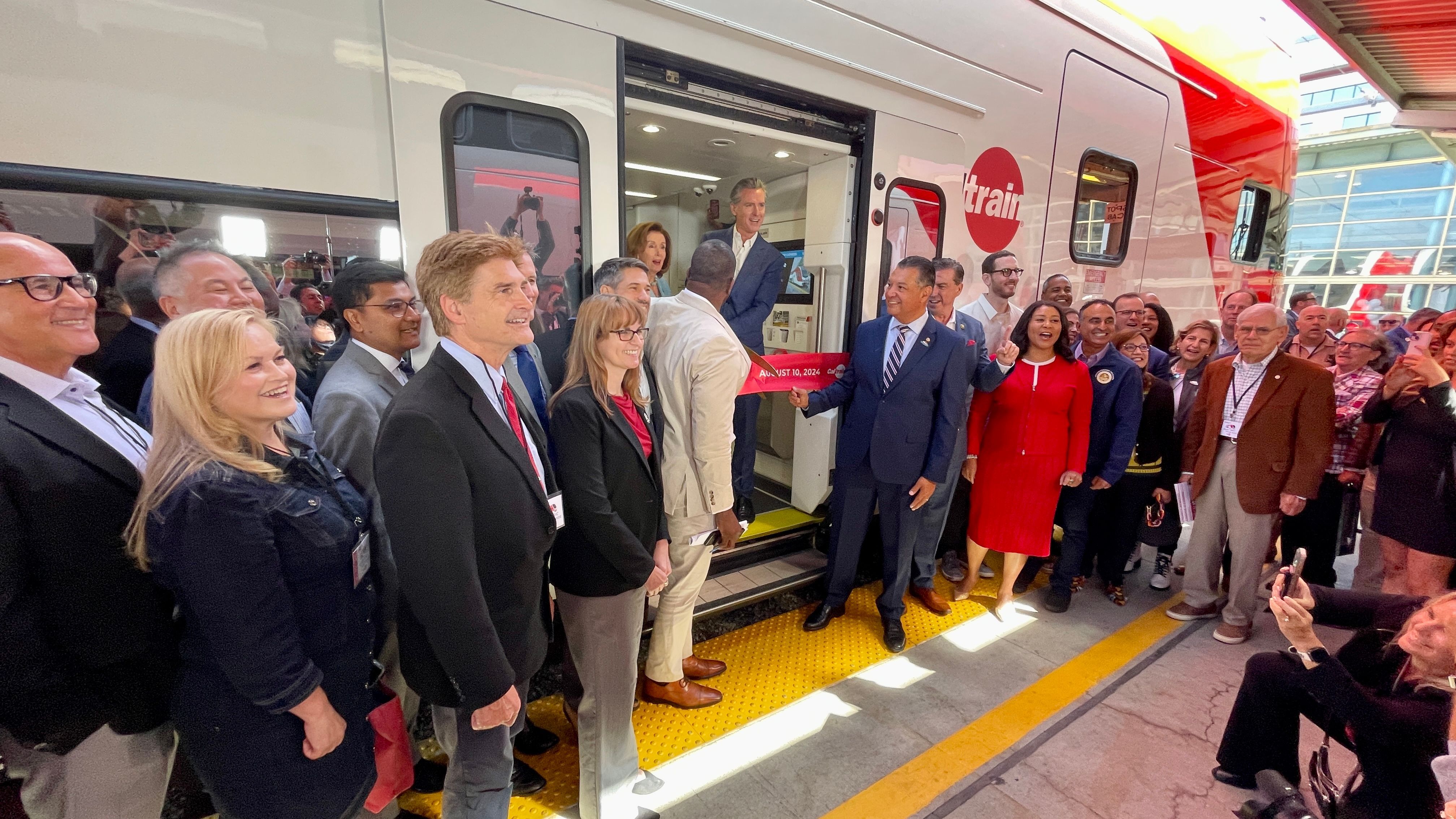Caltrain celebrates its milestone as the first electrified commuter rail system in California between SF and San Jose


(SAN FRANCISCO) After a decade's planning, building and testing, Caltrain has become the first electrified commuter rail system in California providing a cleaner and faster train service starting September 21, 2024.
The inaugural run for Caltrain's electric trains was held on August 10, 2024 at the San Francisco Station. Governor Gavin Newsom, Speaker Emeritus Nancy Pelosi, U.S. Senator Alex Padilla and elected officials from San Francisco, San Mateo County, Santa Clara County and San Jose attended the historic first ride on Caltrain’s new electric fleet between San Francisco and San Jose.
“High-speed rail linked to an electrified Caltrain will not just get Californians where they’re going faster, it’s connecting communities and driving economic growth,” said Newsom. “The completed Caltrain project is an integral part of high-speed rail and the story California is telling about clean transportation. And Californians are already seeing the results for themselves as we electrify Caltrain, finish structures, lay track, design and build stations, and buy trains. We’re making rail real in California.”
“Caltrain electrification means shorter commutes, cleaner air and good-paying jobs in the Bay Area and beyond. It was my great pleasure to join so many leaders for the first ride on Caltrain’s new electric fleet,” Pelosi said.
"It is a dream turned into vision," said Congressional Member Anna Eshoo who represents the South Bay. "The 21st century electrified Caltrain will travel faster, cleaner and quieter for the people of our region.”
Caltrain was originally built in 1863 under the authority of the San Francisco and San Jose Railroad. Southern Pacific purchased the rail system in 1870 and provided commuter railroad train service since then. Its ridership declined with the rise in automobile use after 1945. The Southern Pacific petitioned the California Public Utilities Commission to discontinue the commuter operation because of ongoing losses.

California legislators passed Assembly Bill 1854 in 1977 which allowed local transit districts to subsidize the rail service until 1980 and authorized California Department of Transportation (Caltrans) to contract with Southern Pacific. Caltrans purchased new locomotives and rolling stocks, replacing equipment in 1985.
The Peninsula Corridor Joint Powers Board was formed in 1987 and bought the railroad right of way between San Francisco and San Jose from Southern Pacific with state and local funds in 1991.
The Board has owned and operated Caltrain since 1992 with nine board members from three transportation agencies equally representing the counties of San Francisco (SF Municipal Transportation Agency - SFMTA), San Mateo (San Mateo County Transit District - SamTrans) and Santa Clara (Santa Clara Valley Transportation Authority).
Caltrain is the oldest continuously operated railroad in the West. After 70 years of diesel trains, Caltrain started planning its electrification with federal and state funds investment in 2016 to electrify the 51-mile rail system.
In addition to purchasing the state-of-the-art electric trains replacing the aging diesel fleet, Caltrain has electrified the 51-mile rail corridor with construction since 2017 and made it the first diesel-to-electric conversion in the U.S.

Caltrain has purchased 23 new high-performance seven-car electric trains to replace the current diesel locomotive trains.
According to Caltrain, the new electric trains offer better experience for riders while providing faster and more frequent service. Express train service takes less than an hour to travel between San Francisco and San Jose with 31 stations in total.
The new electric trains will also increase service by 20% with 16 stations having trains arriving every 15-20 minutes at peak hours and all stations receiving service every 30 minutes during mid-day, evenings and weekends compared to the hourly service presently.
In the environmental perspective, the electric trains would reduce noise and air pollution by 26%. "Electrification will help meet ambitious regional and state climate action goals by lowering greenhouse gas emissions, improving air quality and relieving traffic congestion," Caltrain stated.
In the meantime, riders may enjoy more and better services and enhance amenities while traveling on board in the electric trains. The advanced services include Wi-Fi, power outlets at each forward-facing seat, energy-efficient lighting, baby-changing tables in the bathroom, security cameras, expanded storage under the cantilevered seats, and two bike cars for bike storage on each train.
- If someone’s vehicle blocks your driveway, San Francisco's 311 service will resolve it easier and safer for you
- U.S. Department of Homeland Security proposes green card status can be denied for Medicaid and SNAP recipients
- NAPCA Column 18: About the One Big Beautiful Bill Act
- San Francisco Real-Time Investigation Center (RTIC) equipped with drones and advanced technologies now fully operates to help keep the city safe
- The community blessed for two Chinese American Police Chiefs in a row to lead San Francisco Police Department
- San Francisco newly-appointed D4 Supervisor Alan Wong votes for Family Zoning Plan in his first full board meeting
- Opinion: My concerns about negative impact of road constructions to traffic and communities in SF’s Chinatown and Sunset
- Tech entrepreneur & political advisor Saikat Chakrabarti runs for Congress to fill Nancy Pelosi’s House seat






